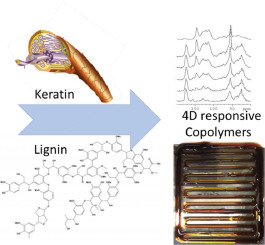当前位置:
X-MOL 学术
›
Acta Biomater.
›
论文详情
Our official English website, www.x-mol.net, welcomes your feedback! (Note: you will need to create a separate account there.)
Combination and processing keratin with lignin as biocomposite materials for additive manufacturing technology.
Acta Biomaterialia ( IF 9.7 ) Pub Date : 2019-12-23 , DOI: 10.1016/j.actbio.2019.12.026 Warren J Grigsby 1 , Sonya M Scott 2 , Matthew I Plowman-Holmes 2 , Paul G Middlewood 2 , Kimberly Recabar 3
Acta Biomaterialia ( IF 9.7 ) Pub Date : 2019-12-23 , DOI: 10.1016/j.actbio.2019.12.026 Warren J Grigsby 1 , Sonya M Scott 2 , Matthew I Plowman-Holmes 2 , Paul G Middlewood 2 , Kimberly Recabar 3
Affiliation

|
Additive manufacturing using Nature's resources is a desirable goal. In this work we examine how the inherent macromolecular properties of keratin and lignin can be utilised and developed using green chemistry principles to form 4D functional materials. A new methodology utilising protein complexation by lignin was applied to form copolymers and reinforce keratin cross-linking networks on aqueous and solid state processing. Solubility, chemical and processing characteristics found a favoured 4:1 ratio of keratin to lignin was most desired for effective further processing as 3D printed paste forms. Thermally processing keratin-lignin with plasticisers and processing aids demonstrated extruded FDM filaments could be formed at temperatures >130°C, but degradation of keratin-lignin materials was observed. Employing paste printing strategies, keratin-lignin hydrogels could successfully print 3D skirt outlines. This was achieved with aqueous hydrogels prepared at 30-40% solids content with and without plasticizers over a defined processing timeframe. Mechanical response to moisture stimuli was successfully demonstrated for the 4:1 keratin-lignin printed material on water soaking, realising the ability of these keratin-lignin biocomposite materials to introduce a 4th dimensional response after 3D printing. STATEMENT OF SIGNIFICANCE: In this paper we describe new perspectives for how biopolymers can be used and processed to develop (co)polymers as 3D & 4D printed responsive materials without the need for synthetic chemical modifications. We utilise a novel methodology employing bioconjugation to synthesise and develop co-polymer materials from keratin and lignin and demonstrate this can be achieved in both water and solid state. We manipulate the inherent chemical attributes of both biopolymers to develop these new functional materials under green chemistry processing conditions. This is a practical example how the chemical coupling of two biopolymers at molecular-scale can be leveraged to give co-polymer materials which retain their inherent macromolecular properties to behave as functional, 4D responsive biomaterials.
中文翻译:

组合和加工角蛋白和木质素作为增材制造技术的生物复合材料。
利用自然资源进行增材制造是一个理想的目标。在这项工作中,我们研究了如何利用绿色化学原理利用角蛋白和木质素的固有大分子特性来加以利用和开发,从而形成4D功能材料。一种利用木质素使蛋白质络合的新方法被应用于形成共聚物,并在水性和固态工艺中增强角蛋白交联网络。溶解度,化学和加工特性发现,角蛋白与木质素的比例为4:1的最佳比例对于3D打印糊状形式的有效进一步加工是最理想的。用增塑剂和加工助剂对角蛋白-木质素进行热处理表明,挤出的FDM长丝可以在> 130°C的温度下形成,但观察到角蛋白-木质素材料的降解。采用粘贴印刷策略,角蛋白-木质素水凝胶可以成功打印3D裙轮廓。这是通过在规定的加工时间内,以固形物含量为30-40%的水性水凝胶在有或没有增塑剂的情况下完成的。已成功证明了4:1角蛋白-木质素印刷材料在水上浸泡后对水分刺激的机械响应,从而实现了这些角蛋白-木质素生物复合材料在3D打印后引入4维响应的能力。意义声明:在本文中,我们描述了如何使用生物聚合物并对其进行加工以开发(共)聚合物作为3D和4D打印的响应材料而无需进行合成化学修饰的新观点。我们利用一种新颖的方法,利用生物共轭从角蛋白和木质素合成并开发出共聚物材料,并证明这可以在水和固态下实现。我们操纵两种生物聚合物的固有化学属性,以在绿色化学加工条件下开发这些新的功能材料。这是一个实际的例子,如何利用两种生物聚合物在分子尺度上的化学偶联来提供保留其固有的大分子性质以充当功能性4D响应生物材料的共聚物材料。
更新日期:2019-12-23
中文翻译:

组合和加工角蛋白和木质素作为增材制造技术的生物复合材料。
利用自然资源进行增材制造是一个理想的目标。在这项工作中,我们研究了如何利用绿色化学原理利用角蛋白和木质素的固有大分子特性来加以利用和开发,从而形成4D功能材料。一种利用木质素使蛋白质络合的新方法被应用于形成共聚物,并在水性和固态工艺中增强角蛋白交联网络。溶解度,化学和加工特性发现,角蛋白与木质素的比例为4:1的最佳比例对于3D打印糊状形式的有效进一步加工是最理想的。用增塑剂和加工助剂对角蛋白-木质素进行热处理表明,挤出的FDM长丝可以在> 130°C的温度下形成,但观察到角蛋白-木质素材料的降解。采用粘贴印刷策略,角蛋白-木质素水凝胶可以成功打印3D裙轮廓。这是通过在规定的加工时间内,以固形物含量为30-40%的水性水凝胶在有或没有增塑剂的情况下完成的。已成功证明了4:1角蛋白-木质素印刷材料在水上浸泡后对水分刺激的机械响应,从而实现了这些角蛋白-木质素生物复合材料在3D打印后引入4维响应的能力。意义声明:在本文中,我们描述了如何使用生物聚合物并对其进行加工以开发(共)聚合物作为3D和4D打印的响应材料而无需进行合成化学修饰的新观点。我们利用一种新颖的方法,利用生物共轭从角蛋白和木质素合成并开发出共聚物材料,并证明这可以在水和固态下实现。我们操纵两种生物聚合物的固有化学属性,以在绿色化学加工条件下开发这些新的功能材料。这是一个实际的例子,如何利用两种生物聚合物在分子尺度上的化学偶联来提供保留其固有的大分子性质以充当功能性4D响应生物材料的共聚物材料。



























 京公网安备 11010802027423号
京公网安备 11010802027423号